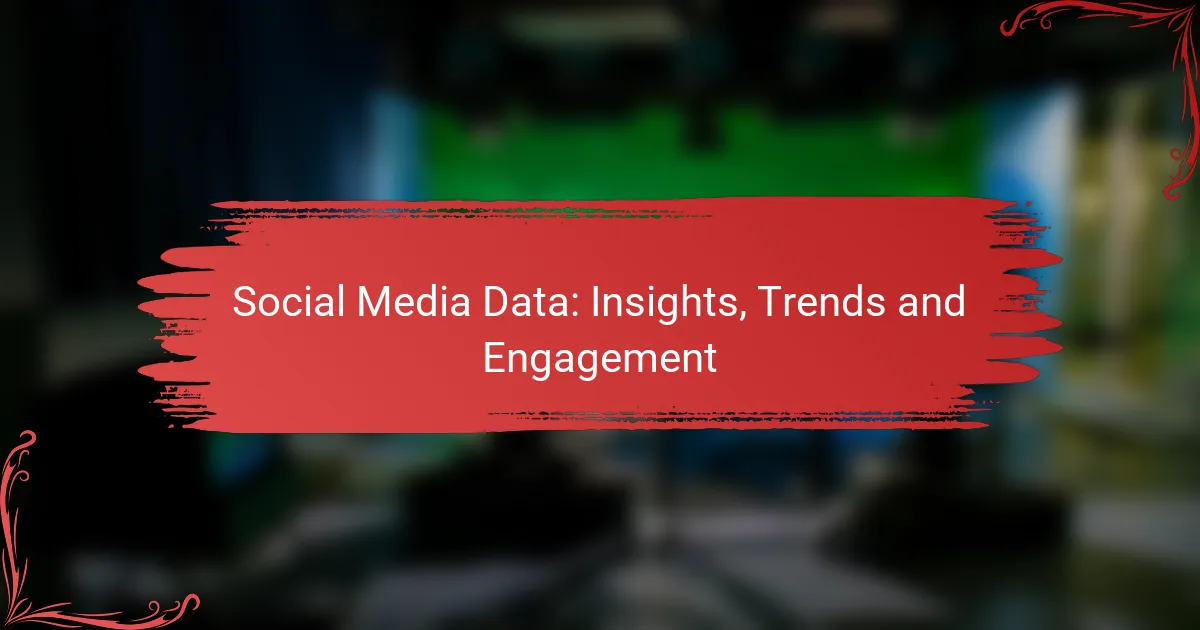Social media data plays a crucial role in enhancing user engagement by offering valuable insights into audience preferences and behaviors. By leveraging real-time analytics and advanced technologies, brands can refine their strategies to foster deeper connections with their customers. Understanding the unique data patterns across different platforms allows businesses to optimize their advertising efforts and improve overall interaction with their audience.
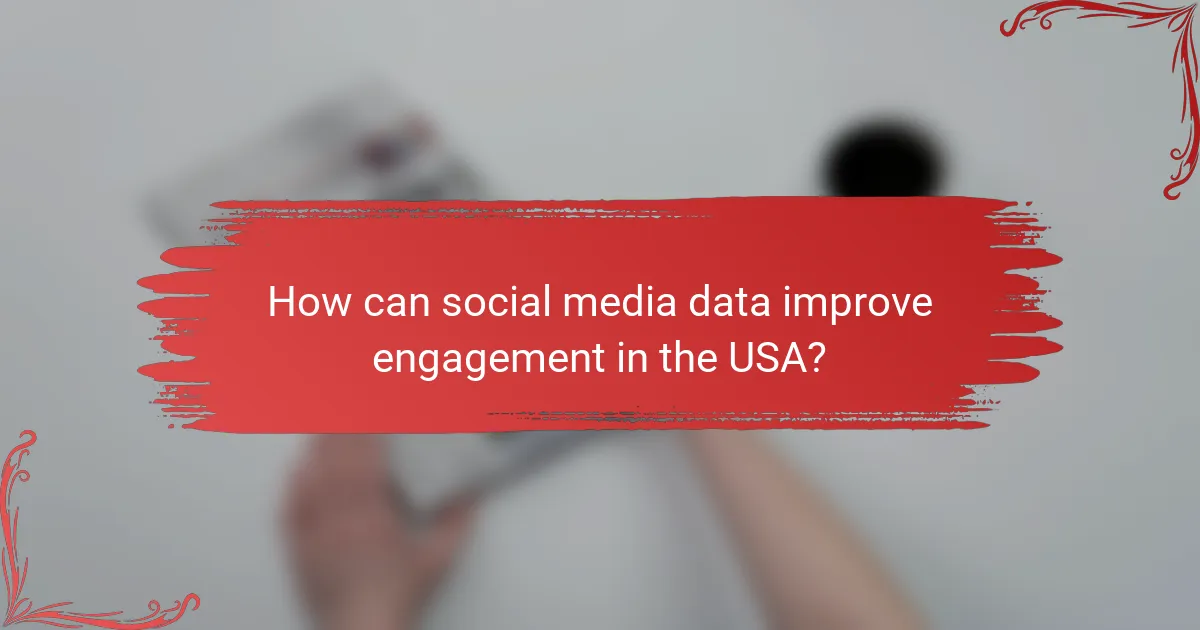
How can social media data improve engagement in the USA?
Social media data can significantly enhance engagement in the USA by providing insights into user preferences and behaviors. By analyzing this data, brands can tailor their strategies to better connect with their audience and foster meaningful interactions.
Targeted advertising strategies
Targeted advertising leverages social media data to reach specific demographics based on interests, behaviors, and location. For instance, a local restaurant can use data to target ads to users within a certain radius, increasing the likelihood of foot traffic. This approach can improve ad performance, often resulting in higher click-through rates and conversions.
When implementing targeted advertising, consider A/B testing different ad formats and messages to identify what resonates best with your audience. Avoid broad targeting; instead, focus on niche segments to maximize engagement and return on investment.
Content personalization techniques
Content personalization involves tailoring posts and messages to individual user preferences based on their interactions and engagement history. For example, a fashion brand might analyze user data to recommend products that align with a customer’s past purchases or browsing behavior. This personalized approach can lead to increased user satisfaction and loyalty.
To effectively personalize content, utilize tools that analyze engagement metrics and user feedback. Regularly update your content strategy to reflect changing trends and preferences, ensuring your audience remains engaged and interested.
Influencer collaborations
Collaborating with influencers can amplify your brand’s reach and engagement by tapping into their established audiences. Social media data can help identify influencers whose followers align with your target market, making partnerships more effective. For example, a beauty brand might partner with a popular beauty vlogger to showcase new products, driving engagement through authentic recommendations.
When selecting influencers, consider their engagement rates and authenticity rather than just follower counts. Establish clear goals for the collaboration and track performance metrics to assess the impact on your brand’s engagement levels.

What are the current trends in social media data analysis?
Current trends in social media data analysis focus on leveraging real-time insights and advanced technologies like AI to enhance user engagement and marketing strategies. Businesses are increasingly adopting these tools to make data-driven decisions that improve their social media presence and customer interactions.
Real-time analytics tools
Real-time analytics tools allow businesses to monitor social media activity as it happens, providing immediate insights into user engagement and content performance. These tools can track metrics such as likes, shares, comments, and overall reach, enabling brands to adjust their strategies on the fly.
Popular tools include Hootsuite, Sprout Social, and Google Analytics, which offer dashboards that visualize data trends. Companies should consider integrating these tools into their social media management to respond quickly to audience feedback and capitalize on trending topics.
AI-driven insights
AI-driven insights utilize machine learning algorithms to analyze vast amounts of social media data, identifying patterns and predicting user behavior. This technology can help brands understand what content resonates with their audience, leading to more effective marketing campaigns.
For instance, AI can segment audiences based on engagement patterns, allowing for targeted advertising that increases conversion rates. Companies should invest in AI tools that provide actionable insights, but they must also ensure data privacy compliance, especially with regulations like GDPR in Europe.
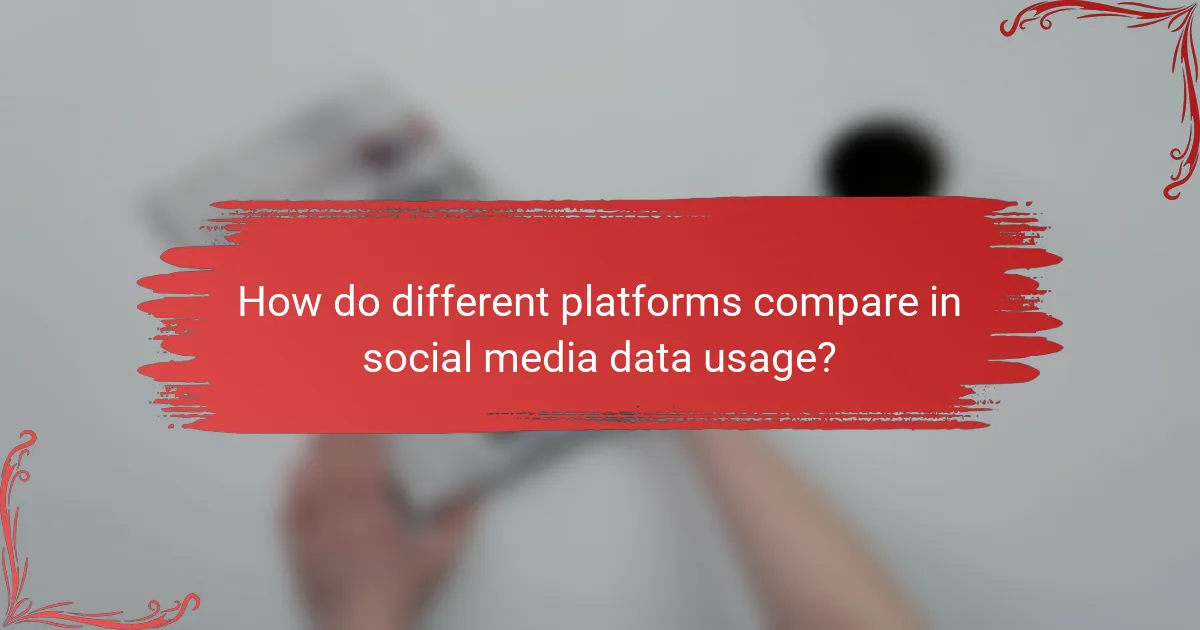
How do different platforms compare in social media data usage?
Different social media platforms exhibit unique data usage patterns that influence advertising strategies and user engagement. Understanding these differences can help businesses tailor their approaches to maximize effectiveness across platforms.
Facebook’s advertising metrics
Facebook provides robust advertising metrics that allow businesses to track performance through various key indicators such as reach, impressions, and click-through rates. Advertisers can analyze data to optimize ad spend, typically aiming for a cost-per-click (CPC) that falls within the low single-digit USD range.
Utilizing Facebook’s Audience Insights can further refine targeting by demographic and behavioral data. Regularly reviewing these metrics helps in adjusting campaigns to improve engagement and conversion rates.
Instagram’s engagement rates
Instagram is known for high engagement rates, often exceeding those of other platforms, with brands typically seeing engagement levels around 1-3%. This platform thrives on visual content, making it essential for businesses to focus on high-quality images and videos to capture audience attention.
Using Instagram Stories and Reels can enhance visibility and interaction. Brands should monitor engagement metrics closely to identify what content resonates best with their audience, allowing for more strategic content planning.
Twitter’s trending topics analysis
Twitter’s trending topics provide real-time insights into what users are discussing, which can be leveraged for timely marketing efforts. Brands should analyze trending hashtags and topics to align their messaging with current conversations, potentially increasing visibility and engagement.
Regularly using Twitter Analytics can help track the performance of tweets and understand audience interactions. Engaging with trending topics can drive traffic and foster community connections, but brands should ensure their contributions are relevant and authentic to avoid backlash.
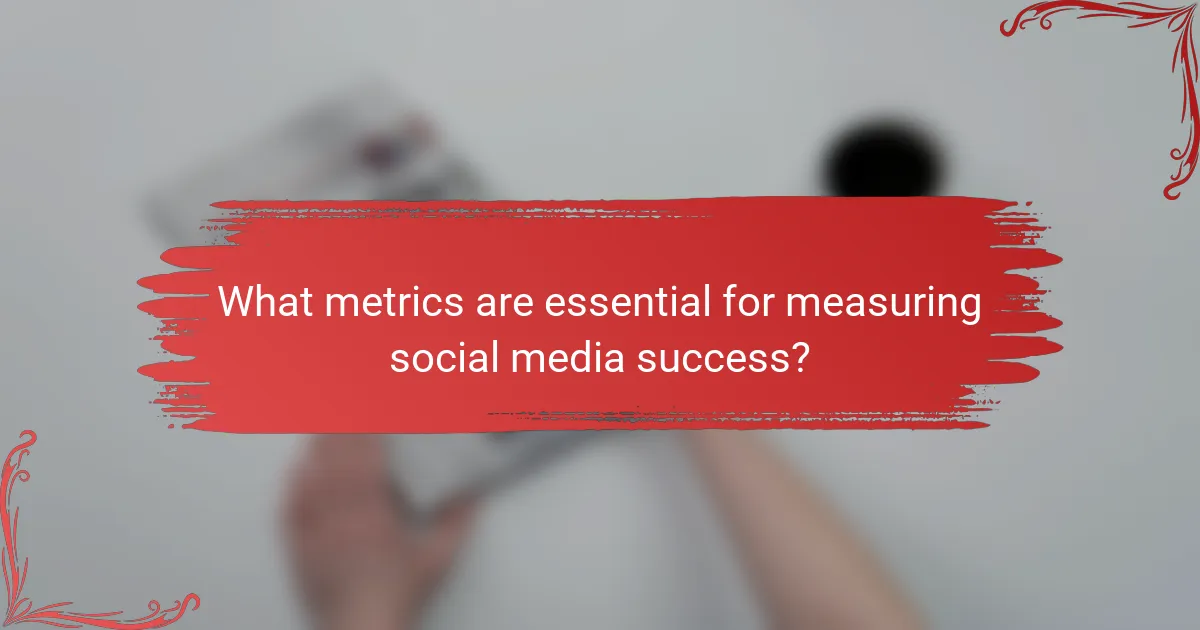
What metrics are essential for measuring social media success?
To measure social media success, focus on key metrics that reflect engagement, conversion, and audience reach. These indicators provide insights into how effectively your content resonates with users and drives desired actions.
Engagement rate
The engagement rate measures how actively users interact with your content, typically calculated as the total engagements (likes, shares, comments) divided by total followers or impressions. A higher engagement rate indicates that your audience finds your content relevant and compelling.
Consider aiming for an engagement rate of around 1-5% for most platforms, though this can vary widely by industry. For example, visual content on Instagram often sees higher engagement compared to text-heavy posts on LinkedIn.
To improve your engagement rate, focus on creating high-quality, shareable content and encourage audience interaction through questions or calls to action.
Conversion rate
The conversion rate tracks the percentage of users who take a desired action after engaging with your social media content, such as making a purchase or signing up for a newsletter. This metric is crucial for understanding the effectiveness of your campaigns in driving business goals.
Typically, a conversion rate of 2-5% is considered average for social media, but this can vary based on the industry and the specific action being measured. For instance, e-commerce sites may see higher conversion rates during promotional campaigns.
To enhance your conversion rate, ensure that your calls to action are clear and compelling, and consider using targeted ads to reach the right audience segments.
Reach and impressions
Reach refers to the total number of unique users who have seen your content, while impressions indicate how many times your content has been displayed, regardless of whether it was clicked. Both metrics are essential for assessing the visibility of your posts.
Monitoring reach and impressions can help you understand the effectiveness of your content distribution strategies. Aim to increase reach by utilizing hashtags, engaging with followers, and collaborating with influencers.
Keep in mind that while high impressions can indicate good visibility, they do not guarantee engagement or conversions. Balance your focus on reach with strategies that foster deeper connections with your audience.
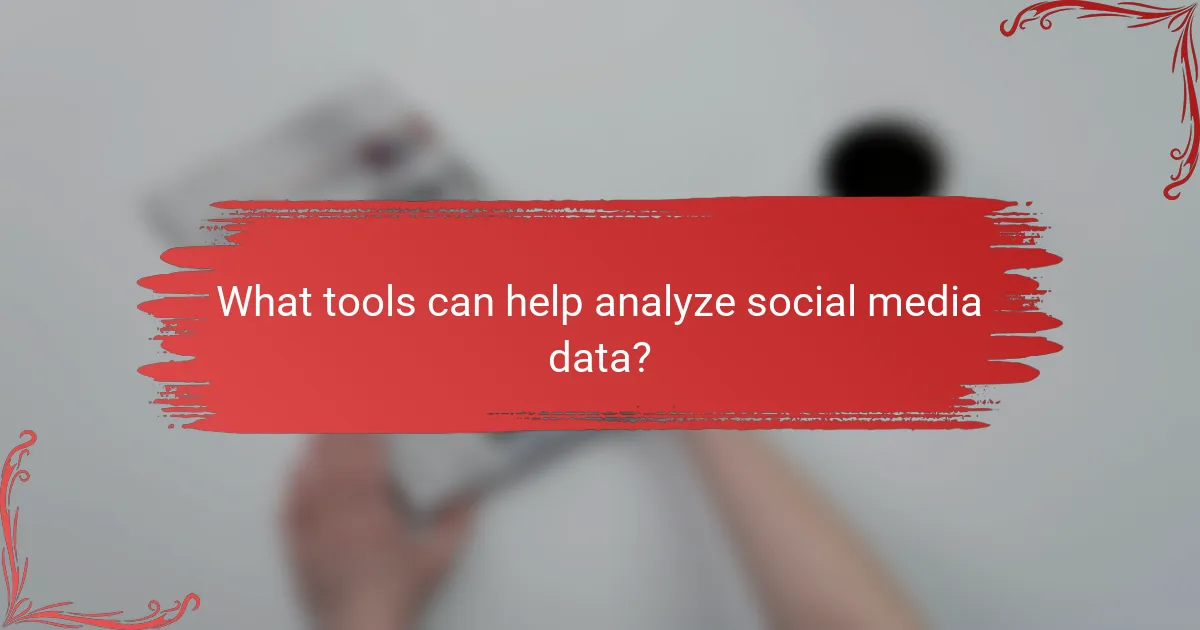
What tools can help analyze social media data?
Several tools can effectively analyze social media data, providing insights into engagement, performance, and audience behavior. These tools help businesses optimize their social media strategies and improve overall engagement.
Hootsuite for scheduling and analytics
Hootsuite is a comprehensive platform that allows users to schedule posts across various social media channels while providing robust analytics. It enables businesses to track performance metrics such as engagement rates, follower growth, and post reach.
When using Hootsuite, consider setting up custom reports to focus on key performance indicators (KPIs) relevant to your goals. This can help you identify trends over time and adjust your strategy accordingly. Be mindful of the platform’s pricing tiers, which vary based on features and the number of users.
Sprout Social for engagement tracking
Sprout Social specializes in engagement tracking and offers tools to monitor conversations and interactions across social media platforms. This tool helps businesses understand audience sentiment and respond effectively to customer inquiries or feedback.
Utilize Sprout Social’s Smart Inbox feature to consolidate messages from different channels, making it easier to manage interactions. Additionally, take advantage of its reporting capabilities to analyze engagement trends and refine your content strategy. Keep in mind that Sprout Social’s pricing may be higher compared to other tools, so assess your budget accordingly.
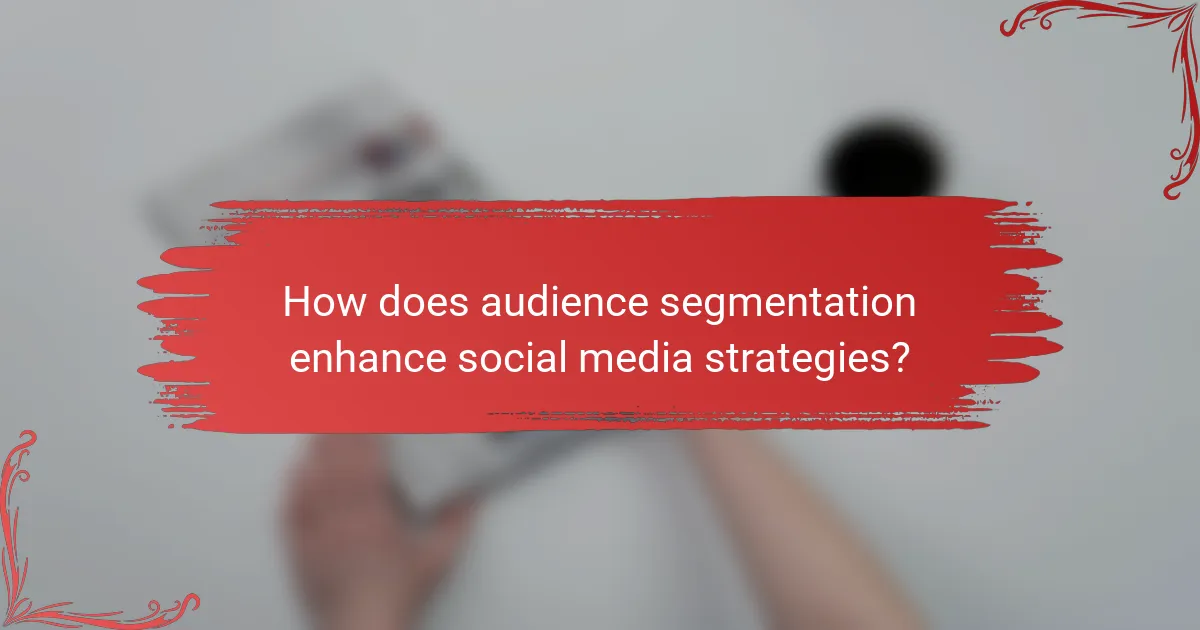
How does audience segmentation enhance social media strategies?
Audience segmentation improves social media strategies by allowing marketers to tailor their content and messaging to specific groups based on demographics, interests, and behaviors. This targeted approach increases engagement, boosts conversion rates, and enhances overall campaign effectiveness.
Understanding Audience Segmentation
Audience segmentation involves dividing a broad audience into smaller, more defined groups to better address their unique needs and preferences. By analyzing factors such as age, location, interests, and online behavior, businesses can create more relevant content that resonates with each segment. This method not only improves engagement but also helps in optimizing ad spend by focusing resources on high-potential groups.
Benefits of Audience Segmentation
Segmenting your audience offers numerous benefits, including increased engagement rates, improved customer satisfaction, and higher conversion rates. For instance, targeted campaigns can lead to engagement rates that are significantly higher than generic messaging, often exceeding 20% in some sectors. Additionally, personalized content fosters a sense of connection, making customers more likely to interact with the brand.
Implementing Audience Segmentation
To effectively implement audience segmentation, start by collecting data through surveys, social media analytics, and customer feedback. Use this information to create distinct segments based on shared characteristics. Consider testing different messaging strategies for each segment to determine what resonates best. Regularly review and adjust your segments as audience preferences evolve over time.
Common Pitfalls to Avoid
One common pitfall in audience segmentation is relying on outdated or incomplete data, which can lead to ineffective targeting. Ensure that your data is current and comprehensive to avoid misrepresenting your audience. Additionally, avoid over-segmenting, as this can complicate your marketing efforts and dilute your messaging. Focus on a manageable number of segments that allow for effective targeting without overwhelming your resources.
